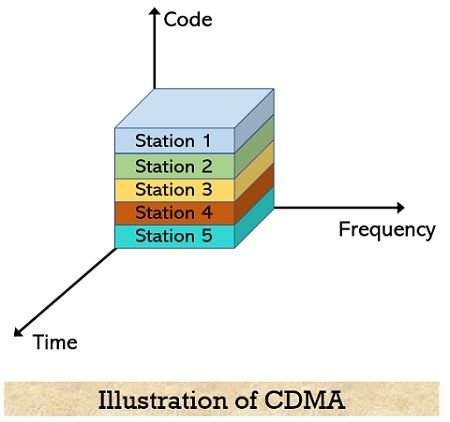CDMA
Code Division Multiple Access (CDMA) is a channel access method used by various radio communication technologies. CDMA allows multiple users to share the same frequency band simultaneously by assigning a unique code to each user. Here’s a breakdown of how CDMA works and its key features:
Key Features of CDMA:
Unique Codes: Each user is assigned a unique spreading code. This code spreads the user's signal over a wider bandwidth, making it distinguishable from other users' signals.
Spread Spectrum Technology: CDMA uses spread spectrum technology, where the signal is spread over a wider frequency band than the original signal. This helps in reducing interference and improving security.
Simultaneous Transmission: Multiple users can transmit simultaneously on the same frequency band without causing significant interference to each other. This is because each user’s signal is encoded with a different spreading code.
Resistance to Interference: The use of unique codes makes CDMA resistant to interference from other signals and noise, as the receiver can separate the desired signal by using the correct code.
Security: The spreading codes provide a level of security, as only the intended receiver with the correct code can decode the signal.
Working of CDMA:
Spreading: Each user's data signal is multiplied by a high-frequency pseudorandom noise (PN) code. This process spreads the data signal across a wide frequency band.
Transmission: The spread signal is transmitted over the air. Multiple users transmit their signals simultaneously in the same frequency band.
Receiving: At the receiver end, the signal is multiplied by the same PN code used for spreading, which despreads the signal back to its original form. Signals that do not match the PN code appear as noise and are not despread, thus minimizing interference.
Applications of CDMA:
Mobile Communication: CDMA is widely used in mobile communication systems, such as CDMA2000 and WCDMA (Wideband CDMA) used in 3G networks.
Satellite Communication: CDMA is also used in satellite communication systems for efficient bandwidth utilization and resistance to interference.
Global Positioning System (GPS): CDMA technology is used in GPS for distinguishing signals from different satellites.
Advantages of CDMA:
Efficient Spectrum Utilization: CDMA allows multiple users to share the same frequency band, leading to efficient use of available spectrum.
Enhanced Capacity: CDMA systems can support more users compared to traditional time-division or frequency-division systems.
Improved Call Quality: CDMA provides better call quality and lower call drop rates due to its resistance to interference.
Increased Security: The use of unique spreading codes adds a layer of security to the communication.
Disadvantages of CDMA:
Complexity: The implementation of CDMA systems is complex due to the need for precise synchronization and code management.
Power Control Issues: CDMA requires effective power control to prevent the "near-far" problem, where signals from nearby users overpower those from distant users.
In summary, CDMA is a sophisticated multiple access technology that efficiently utilizes the available spectrum, supports a large number of users, and provides robust performance in terms of interference resistance and security.

Congratulations, your post has been upvoted by @upex with a 0.31% upvote. We invite you to continue producing quality content and join our Discord community here. Visit https://botsteem.com to utilize usefull and productive automations #bottosteem #upex